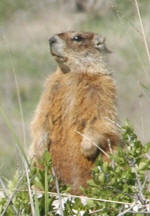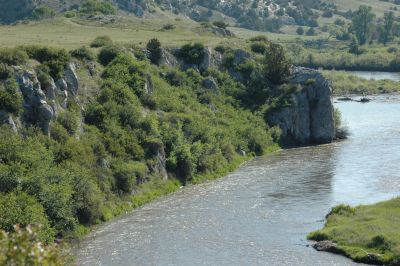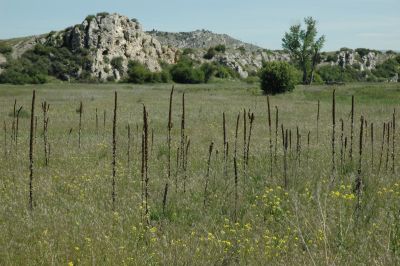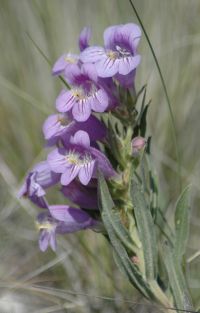|
||||||
|
"... we called the S.W. fork, that which we meant to ascend, Jefferson's River in honor of that illustrious personage Thomas Jefferson. [the author of our enterprize.] the Middle fork we called Madison's River in honor of James Madison, and the S.E. Fork we called Gallitin's River in honor of Albert Gallitin. ... the beds of all these streams are formed of smooth pebble and gravel, and their waters perfectly transparent; in short they are three noble streams". (Meriwether Lewis, July 28, 1805)
A few short years after Lewis and Clark traveled through the Headwaters area, John Colter, former member of the Lewis and Clark Expedition, returned to the area as a scout for a fur trading company. On that journey, Blackfeet Indians captured Colter. According to Colter's recollection, the Blackfeet stripped him naked, and told him to run for his life, giving him a head start. The fleet Colter managed to outrun the Blackfeet, killing one in the progress, and surviving off the land in the weeks that followed. In the Blackfeet version of the story, however, Colter was allowed to escape, in order that he might warm other whites not to intrude upon Indian territory. Some other early explorers, not as fortunate as Colter, lost their lives to the Blackfeet, as the Indians strove to defend their land.
The fertile valley and availability of river navigation soon lured settlers. As Civil War gripped the nation, eleven Missourians put down stakes at the Three Forks, convinced that commerce would arrive above the Great Falls, and hoping to supply the gold camps as far away as Virginia City and Helena. Founded in 1862, Gallatin City was barely a year old when John Bozeman of Georgia arrived in the valley and platted out, thirty miles to the east, the town that would later bear his name. Although Gallatin City in 1865 was moved across the river and renamed Gallatin City II, the town of Bozeman proved to be more sustainable than Gallatin City. The latter gradually grew until 1883, when the Northern Pacific decided to lay its track to the south of town, effectively consigning the small town to death. By 1890, the town lay empty.
Today, Three Forks, six miles from the Missouri Headwaters State Park, is a thriving community located in the fastest growing county in Montana. A residential path for walkers, runners and bicyclers links Three Forks to the park. As Gallatin County struggles to deal with land management issues in the face of rapid residential and commercial growth in the Gallatin Valley, Three Forks, while retaining its reputation as a small western town, is now within easy commuting distance of Bozeman. Missouri Headwaters State Park features several miles of paths, collectively traversing the old Gallatin City town site along the banks of the Gallatin, rising to the top of the bluff overlooking the river valley, and leading to the the convergence of the rivers. Interpretive stations relate the history of the area from ancient times to the modern era. The park is home to a variety of birds and mammals, and wildflowers dot the landscape during the spring months.
Montana History Net is produced by Bruce Gourley. Web site and photographs © 2007 Bruce Gourley. |
||||||

 In their search for a
northwest water passage, Lewis and Clark came upon the Headwaters of the
Missouri on July 25, 1805. The natural crossroads was already a
meeting place for Native Americans.
In their search for a
northwest water passage, Lewis and Clark came upon the Headwaters of the
Missouri on July 25, 1805. The natural crossroads was already a
meeting place for Native Americans.  But
the fur trappers did come, furiously pursuing beaver pelts in the Three
Forks area. In a little more than a decade, the Headwaters was
trapped out, and by 1822 the trappers had moved on elsewhere.
However, several famous early western figures, including
Jedediah Smith, William Sublette, and scout Kit Carson, traversed the
Headwaters during the first half of the century.
But
the fur trappers did come, furiously pursuing beaver pelts in the Three
Forks area. In a little more than a decade, the Headwaters was
trapped out, and by 1822 the trappers had moved on elsewhere.
However, several famous early western figures, including
Jedediah Smith, William Sublette, and scout Kit Carson, traversed the
Headwaters during the first half of the century. Another chapter in
the life of the Headwaters area took place in 1908, when the Milwaukee
Railroad brought life back to the area and led to the founding of the town
of Three Forks.
Another chapter in
the life of the Headwaters area took place in 1908, when the Milwaukee
Railroad brought life back to the area and led to the founding of the town
of Three Forks.